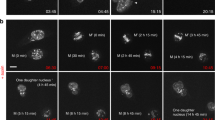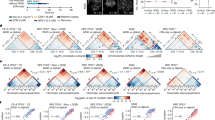Abstract
Chromosomal instability is a key step in the generation of the cancer cell karyotype. An indicator of unstable chromosomes is the presence of chromatin bridges during anaphase. We examined in detail the fate of anaphase bridges in cultured oral squamous cell carcinoma cells in real-time. Surprisingly, chromosomes in bridges typically resolve by breaking into multiple fragments. Often these fragments give rise to micronuclei (MN) at the end of mitosis. The formation of MN is shown to have important consequences for the cell. We found that MN have incomplete nuclear pore complex (NPC) formation and nuclear import defects and the chromatin within has greatly reduced transcriptional activity. Thus, a major consequence of the presence of anaphase bridges is the regular sequestration of chromatin into genetically inert MN. This represents another source of ongoing genetic instability in cancer cells.








Similar content being viewed by others
Abbreviations
- GFP:
-
Green fluorescent protein
- MN:
-
Micronucleus/micronuclei
- DAPI:
-
4′, 6-Diamidino-2-phenylindole
- NPC:
-
Nuclear pore complex
- GR:
-
Glucocorticoid receptor
- UTP:
-
Uridine 5′triphosphate
- PolII:
-
RNA polymerase II
References
Artandi SE, Chang S, Lee SL, Alson S, Gottlieb GJ, Chin L, DePinho RA (2000) Telomere dysfunction promotes non-reciprocal translocations and epithelial cancers in mice. Nature 406:641–645
Bajer A (1963) Observations on dicentrics in living cells. Chromosoma 14:18–30
Bajer A (1964) Cine-micrographic studies on dicentric chromosomes. Chromosoma 15:630–651
Bregman DB, Du L, Li Y, Ribisi S, Warren SL (1994) Cytostellin distributes to nuclear regions enriched with splicing factors. J Cell Sci 107:387–396
Carey KL, Richards SA, Lounsbury KM, Macara IG (1996) Evidence using a green fluorescent protein-glucocorticoid receptor chimera that the Ran/TC4 GTPase mediates an essential function independent of nuclear protein import. J Cell Biol 133:985–996
Coelho PA, Queiroz-Machado J, Sunkel CE (2003) Condensin-dependent localisation of topoisomerase II to an axial chromosomal structure is required for sister chromatid resolution during mitosis. J Cell Sci 116:4763–4776
Daigle N, Beaudouin J, Hartnell L, Imreh G, Hallberg E, Lippincott-Schwartz J, Ellenberg J (2001) Nuclear pore complexes form immobile networks and have a very low turnover in live mammalian cells. J Cell Biol 154:71–84
Davis LI, Blobel G (1986) Identification and characterization of a nuclear pore complex protein. Cell 45:699–709
Dearfield KL, Auletta AE, Cimino MC, Moore MM (1991) Considerations in the US Environmental Protection Agency’s testing approach for mutagenicity. Mutat Res 258:259–283
Fenech M (1993) The cytokinesis-block micronucleus technique: a detailed description of the method and its application to genotoxicity studies in human populations. Mutat Res 285:35–44
Fenech M (1998) Important variables that influence base-line micronucleus frequency in cytokinesis-blocked lymphocytes—a biomarker for DNA damage in human populations. Mutat Res 404:155–165
Fouladi B, Sabatier L, Miller D, Pottier G, Murnane JP (2000) The relationship between spontaneous telomere loss and chromosome instability in a human tumor cell line. Neoplasia 2:540–554
Gavrieli Y, Sherman Y, Ben-Sasson SA (1992) Identification of programmed cell death in situ via specific labeling of nuclear DNA fragmentation. J Cell Biol 119:493–501
Gisselsson D (2003) Chromosome instability in cancer: how, when, and why? Adv Cancer Res 87:1–29
Gisselsson D, Bjork J, Hoglund M, Mertens F, Dal Cin P, Akerman M, Mandahl N (2001) Abnormal nuclear shape in solid tumors reflects mitotic instability. Am J Pathol 158:199–206
Grote SJ, Joshi GP, Revell SH, Shaw CA (1981) Observations of radiation-induced chromosome fragment loss in live mammalian cells in culture, and its effect on colony-forming ability. Int J Radiat Biol Relat Stud Phys Chem Med 39:395–408
Haering CH, Nasmyth K (2003) Building and breaking bridges between sister chromatids. Bioessays 25:1178–1191
Hande MP, Samper E, Lansdorp P, Blasco MA (1999) Telomere length dynamics and chromosomal instability in cells derived from telomerase null mice. J Cell Biol 144:589–601
Heddle JA (1990) Micronuclei in vivo. Prog Clin Biol Res 340B:185–194
Heddle JA, Cimino MC, Hayashi M, Romagna F, Shelby MD, Tucker JD, Vanparys P, MacGregor JT (1991) Micronuclei as an index of cytogenetic damage: past, present, and future. Environ Mol Mutagen 18:277–291
Huang X, Gollin SM, Raja S, Godfrey TE (2002) High-resolution mapping of the 11q13 amplicon and identification of a gene, TAOS1, that is amplified and over expressed in oral cancer cells. Proc Natl Acad Sci U S A 99:11369–11374
Jallepalli PV, Lengauer C (2001) Chromosome segregation and cancer: cutting through the mystery. Nat Rev Cancer 1:109–117
Jenssen D (1982) The induction of micronuclei. In: Alan R (ed) Sister chromosome exchange. Liss, New York, pp 47–63
Kanda T, Sullivan KF, Wahl GM (1998) Histone-GFP fusion protein enables sensitive analysis of chromosome dynamics in living mammalian cells. Curr Biol 8:377–385
Kato H, Sandberg AA (1968) Chromosome pulverization in human cells with micronuclei. J Natl Cancer Inst 40:165–179
Kirsch-Volders M, Fenech M (2001) Inclusion of micronuclei in non-divided mononuclear lymphocytes and necrosis/apoptosis may provide a more comprehensive cytokinesis block micronucleus assay for biomonitoring purposes. Mutagenesis 16:51–58
Kirsch-Volders M, Elhajouji A, Cundari E, Van Hummelen P (1997) The in vitro micronucleus test: a multi-endpoint assay to detect simultaneously mitotic delay, apoptosis, chromosome breakage, chromosome loss and non-disjunction. Mutat Res 392:19–30
Labidi B, Gregoire M, Frackowiak S, Hernandez-Verdun D, Bouteille M (1987) RNA polymerase activity in PtK1 micronuclei containing individual chromosomes. An in vitro and in situ study. Exp Cell Res 169:233–244
de Lange T (2002) Protection of mammalian telomeres. Oncogene 21:532–540
McNeil PL (1989) Incorporation of macromolecules into living cells. Methods Cell Biol 29:153
McClintock B (1941) Spontaneous alterations in chromosome size and form in Zea mays. Cold Spring Harb Symp Quant Biol 9:72–81
Miller BM, Zitzelsberger HF, Weier HU, Adler ID (1991) Classification of micronuclei in murine erythrocytes: immunofluorescent staining using CREST antibodies compared to in situ hybridization with biotinylated gamma satellite DNA. Mutagenesis 6:297–302
Montgomery E, Wilentz RE, Argani P, Fisher C, Hruban RH, Kern SE, Lengauer C (2003) Analysis of anaphase figures in routine histologic sections distinguishes chromosomally unstable from chromosomally stable malignancies. Cancer Biol Ther 2:248–252
Muller-Tegethoff K, Kersten B, Kasper P, Muller L (1997) Application of the in vitro rat hepatocyte micronucleus assay in genetic toxicology testing. Mutat Res 392:125–138
Norppa H, Falck GC (2003) What do human micronuclei contain? Mutagenesis 18:221–233
Ochs RL (1998) Methods used to study structure and function of the nucleolus. Methods Cell Biol 53:303–321
Patturajan M, Schulte RJ, Sefton BM, Berezney R, Vincent M, Bensaude O, Warren SL, Corden JL (1998) Growth-related changes in phosphorylation of yeast RNA polymerase II. J Biol Chem 273:4689–4694
Rogakou EP, Pilch DR, Orr AH, Ivanova VS, Bonner WM (1998) DNA double-stranded breaks induce histone H2AX phosphorylation on serine 139. J Biol Chem 273:5858–5868
Rudolph KL, Millard M, Bosenberg MW, DePinho RA (2001) Telomere dysfunction and evolution of intestinal carcinoma in mice and humans. Nat Genet 28:155–159
Russo A, Levis AG (1991) The contribution of the mouse spermatid micronucleus assay to the detection of germinal mutagens. Prog Clin Biol Res 372:513–520
Schiffmann D, De Boni U (1991) Dislocation of chromatin elements in prophase induced by diethylstilbestrol: a novel mechanism by which micronuclei can arise. Mutat Res 246:113–122
Schlegel R, MacGregor JT (1984) The persistence of micronucleated erythrocytes in the peripheral circulation of normal and splenectomized Fischer 344 rats: implications for cytogenetic screening. Mutat Res 127:169–174
Shelby MD (1988) The genetic toxicity of human carcinogens and its implications. Mutat Res 204:3–15
Smith AH, Hopenhayn-Rich C, Warner M, Biggs ML, Moore L, Smith MT (1993) Rationale for selecting exfoliated bladder cell micronuclei as potential biomarkers for arsenic genotoxicity. J Toxicol Environ Health 40:223–234
Sukegawa J, Blobel G (1993) A nuclear pore complex protein that contains zinc finger motifs, binds DNA, and faces the nucleoplasm. Cell 72:29–38
Surralles J, Natarajan AT (1997) Human lymphocytes micronucleus assay in Europe. An international survey. Mutat Res 392:165–174
Swedlow JR, Hirano T (2003) The making of the mitotic chromosome. Modern insights into classical questions. Mol Cell 11:557–569
Tates AD, van Welie MT, Ploem JS (1990) The present state of the automated micronucleus test for lymphocytes. Int J Radiat Biol 58:813–825
Termini J (2000) Hydroperoxide-induced DNA damage and mutations. Mutat Res 450:107–124
Thomas P, Umegaki K, Fenech M (2003) Nucleoplasmic bridges are a sensitive measure of chromosome rearrangement in the cytokinesis-block micronucleus assay. Mutagenesis 18:187–194
Titenko NV, Evsikov VI (1977) Micronucleus and cytogenetic disorders in mouse embryos before implantation. Tsitol Genet 11:17–22
Toledo F, Le Roscouet D, Buttin G, Debatisse M (1992) Co-amplified markers alternate in megabase long chromosomal inverted repeats and cluster independently in interphase nuclei at early steps of mammalian gene amplification. EMBO J 11:2665–2673
Trizna Z, Schantz SP (1992) Hereditary and environmental factors associated with risk and progression of head and neck cancer. Otolaryngol Clin North Am 25:1089–1103
Tucker JD, Preston RJ (1996) Chromosome aberrations, micronuclei, aneuploidy, sister chromatid exchanges, and cancer risk assessment. Mutat Res 365:147–159
Umegaki K, Fenech M (2000) Cytokinesis-block micronucleus assay in WIL2-NS cells: a sensitive system to detect chromosomal damage induced by reactive oxygen species and activated human neutrophils. Mutagenesis 15:261–269
Wieland T, Faulstich H (1991) Fifty years of amanitin. Experientia 47:1186–1193
Acknowledgements
The authors gratefully acknowledge: Dr. D. DeFranco for the gift of the GFP-GR, Dr. U. Surti for the JAR cells, Dr. C. Walsh for the anti-tubulin antibodies, Dr. C. Feghali for the anti-centromere antibodies, and the tissue bank of the Oral Cancer Center of Discovery of the University of Pittsburgh Medical Center and Dr. Jennifer Hunt for the tumor samples and the University of Pittsburgh Cancer Institute for material support. We also thank Dr. Nicholas Quintyne and Janet Reing for critical review of the manuscript. The work was supported by National Institutes of Health Grant P60DE13059 to Dr. Eugene N. Myers.
Author information
Authors and Affiliations
Corresponding author
Electronic Supplementary Material
Rights and permissions
About this article
Cite this article
Hoffelder, D.R., Luo, L., Burke, N.A. et al. Resolution of anaphase bridges in cancer cells. Chromosoma 112, 389–397 (2004). https://doi.org/10.1007/s00412-004-0284-6
Received:
Revised:
Accepted:
Published:
Issue Date:
DOI: https://doi.org/10.1007/s00412-004-0284-6




